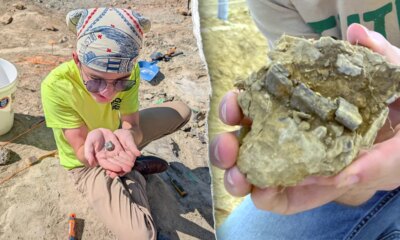Augusta, GA
Hometown History: The Augusta Canal

AUGUSTA, Ga (WJBF)- Many people drive across it or run, walk and bike beside it every day. Many kayak and fish on it too. We’re talking about the Augusta Canal.
In this month’s “Hometown History,” Kim Vickers dives into learning more about it’s origins and how it saved Augusta.
The Augusta Canal has been part of the Garden City’s landscape for nearly 180 years. Since it was built, it has been used for water power, transportation and the city’s primary water supply. In fact, it’s the only canal in the country still being used for its original purposes.
“The whole idea of the canal came about because in the 1840’s, the South was going was very agricultural and the South was actually going through a bit of an economic depression, including Augusta. A lot of folks were packing up and moving out West during westward expansion,” explained Julianna Shurtleff, Education Program Director at the Augusta Canal Discovery Center.
Because of the economic depression, Augusta was in danger of becoming a ghost town.
Shurtleff told Kim Vickers that Henry Cumming, the son of Augusta’s first mayor, believed Augusta should stop shipping cotton up north for production. He proposed that Augusta should build a canal to create industry and make textiles locally in order to boost the economy.

“He knew that we could have a canal because of the Savannah River and the geography of the land here. We’re on the fall line. So, the land dropped from the piedmont to the coastal plain here,” said Shurtleff. “So, if you’ve been out on the canal, you know it’s higher than the river. So, the water would drop from the canal, spin turbines and factories and run machines. It’s amazing that they could figure that out in 1845.”
Cumming dreamed that Augusta could be like Lowell, Massachusetts, the center of the Industrial Revolution. But first, he needed to rally support.
“You look at history books and back in the 1840’s, in the South, a lot of Southerners were not open to industrial life. They were still farmers and agricultural. So, you know, it was this Yankee idea, I guess you’d say, that…having industry in the South. So, he had to gain some support,” Shurtleff said.
Cumming hired the chief engineer of the Georgia Railroad, John Edgar Thomson, and a local surveyor, William Phillips, to determine what the fall on the Savannah River was and if it was enough to create power.

“And he really felt like we could have a hydropower canal here, that would be hydro mechanical to begin with, before electricity, where the water would fall on turbines that turned, but they would just be connected to more wheels and shafts and belts that would transfer the force from there to every piece of equipment in the middle,” said Julie Boone, Former Education Program Director & Volunteer at the Discovery Center.
Boone said that once Cummings secured support, he had to figure out how to pay for it.
“And how to get the money was a real problem. Of course, the first money came out of Mr. Cummings own pocket to do this. So, but with the help of investors, it was started and it was built.”
Shurtleff added that local land owners paid for some of it too.
“A lot of the land that was part of the original layout of the canal, were farms and plantations, and they would pay out of their pocket to help dig that part of the canal.”
The Savannah River drops 52 feet over 7 miles through Augusta. The plan was for the canal to be built in three levels south of the river through the center of the city.

The first level channeled water from the river, the second carried the water mast the mills, providing power and the third released the water back into the river.
“So the idea was to build the canal, to stay at the Piedmont level. So up at the head gates at Savannah Rapids, the canal and the are river level. Then the canal stays higher as the river drops and as the river drops through town, that water would stay higher. And it would drop into mills and spin turbines,” Shurtleff explained.
In May of 1845, construction on the canal began. White laborers from the Georgia Railroad started the work- but before long the summer heat was too much.
African Americans, both enslaved and freed, finished the work.

“It was a lot of slave labor. Some few immigrants maybe thrown in here and there, but mostly slave labor because no one else would sacrifice having to deal with the heat in the summer,” said Boone. “We have to kindly acknowledge slave labor dug the canal at the same time, we still have to remember that we condemn why.”
It was hot and miserable work and the men that were paid for their work weren’t paid much- only $85 a year.
Today, that equals a little more than $3,500.
It took 3 years to build all three levels of the Augusta canal, which looked a lot different then than it does now.
“It was only about 5 to 7 feet deep and about 40 feet wide, ” said Boone.
If you build it they will come. As soon as the first level of the canal was complete, industrial factories began popping up.
James Coleman’s saw and gristmill began production on the canal in April of 1848. A month later the Augusta Factory began producing textiles.
Then, when Georgia seceded from the Union during the Civil War, Colonel George Rains picked Augusta to build a gun powder factory, thanks to the canal.

“It did impact big when the Confederate Powder Works factory was built here. That gave it, you know, a name of like, okay, this canal water’s working for the South,” Shurtleff said. “It made over 3 million pounds of gunpowder by the end of the Civil War- the second largest gunpowder factory in the world.”
The 28 Confederate Powder Works buildings were the only ones ever constructed by the Confederate government.
After the war, the success of the canal and the industry it attracted encouraged local leaders to expand.
“So at that time, the city administration and city, you know, big guys were like, ‘oh, this is a good idea, maybe. So, that’s when they invested in expanding the canal. It was expanded in the 1870’s to about 100 to 150 feet wide and 11 to 15 feet deep,” said Shurtleff.
Mayor Charles Estes hired Charles Olmstead, an engineer he’d worked with on the Erie Canal in New York.
In 1872, work to widen the canal began. This time the laborers were made up if Irish and Italian immigrants. The Italians dammed Rae’s Creek, and created what would become Lake Olmstead.
Plus, more than 200 Chinese immigrants were hired to work on the project, and they brought more efficient digging tools with them.

“And with them, they brought modern steam power tools and machines. So they were hired. They came to Augusta, the first Chinese immigrants to the city of Augusta. And it’s really neat because some Chinese in Augusta now can still trace their lineage back to those original immigrants that came to dig the canal in the 1870’s,” Shurtleff explained.
“It was a big deal when they came to town. We were a little Georgia town and no one had ever seen anyone from China. And everybody went to the railroad station. And generally speaking, they were very accepted within the town,” Boone added.


With the widening of the canal, came more industry. Sibley, Enterprise and John P. King Mills were built along the banks of the canal. The rise of the factories brought more people to Augusta.
“And from 1870 to 1890, after the grand enlargement, the city’s population went from 15,000, to over 33,000 people,” said Shurtleff.
People flocked to Augusta to take jobs in the factories along the canal.


“People moving in. They could work in these factories. It was a job that women could have and make money. Children would work in the factories and help their family,” said Shurtleff. “You would have a company and house that you would rent from the company you worked for that was already built and you kind of had a little mill life. So, you know, Harrisburg, which is a famous neighborhood in Augusta, is a mill village.”
As industry continued to flourish, tourism came to Augusta.
“So, the Georgia coast and where we are, this is about as far south as people traveled in the winter. So we became a winter resort with big hotels and big golf courses. And, you know, where that led to. It led, of course, to the building of the Augusta National. Bobby Jones came here as a tourist and played a little golf and liked it,” Boone said.
As technology advanced, so did the uses for the canal. Augusta was the first city in the South to generate electricity to power street cars and streetlights, and later businesses and homes.
Over time, major floods caused damage to both the canal and the factories. The factories began to close and move overseas and the now polluted canal was neglected by the city.
“The city of Augusta was like, Well, why don’t we fill it in? They were going to build a bypass out to Columbia County and put it through the canal and a golf course,” said Shurtleff. “And the city… a lot of city locals, especially that grew up along the canal, riding their bikes, hiking the trails, were like ‘No. We want to save the canal.’”
Volunteers cleaned up the canal. In 1971, Henry Cumming’s great Grandson, Joseph Cumming, had the canal placed on the National Register of Historic Place.
In 1989, the Augusta Canal Authority was established by the state legislature as the managing body of the waterway.

“And then the Augusta Canal Authority made a master plan. And part of that master plan was becoming a National Heritage Area. And that was in 1996,” said Shurtleff.
In 2003, the Augusta Canal Discovery center opened in a newly revitalized Enterprise Mill. It houses a museum exhibit reminding people of the blood, sweat and tears that went into the canal’s construction and what mill life was like.

People can also enjoy boat tours to learn more.
“Big boats are electric as well. There are batteries on them that are charged up at the dock with hydropower made…well generated right here in the Enterprise Mill. So the canal boats actually run on canal power,” Boone said.
Several tragic incidents are connected to the canal. In 1902, Dennis Cahill, a city worker, drowned trying to rescue a child who had fallen in.
In 1906, Maude Williamson, a worker at Sibley Mill, broke off an affair with Arthur Glover, a married man. It didn’t sit well with him and he murdered her.
Since then, people have reported some spooky sightings.
“So, she was murdered in 1906 by her jilted lover, and she is seen by many workers throughout the years. And they even did a Ghost Asylum TV show on Maude a few years ago,” said Shurtleff.
And in 1951, the body of 7-year-old Lois Jane was found in the canal by Lovey Ivey.

Shurtleff told Kim Vickers that there are reports of strange things happening at Enterprise Mill.
Police said he confessed to her murder and pointed the finger at the child’s family members as conspirators.
“She had gone to the store for her grandmother and never returned. They decided that the grandmother had hired some guy that just hung around town to kill her granddaughter for insurance money,” Boone explained.
“Here in Enterprise Mill, we’ve had little things happen throughout the museum that are odd, and security guards always tells us stories of things they see at night or walking the halls.”
Both Shurtleff and Boone said they are fascinated by the history of the Augusta Canal and love sharing it with others.
“You’re constantly learning. People have questions. The best thing, the sense of community with the overall Augusta community and the tight knit sense of community within the Canal organization,” explained Boone.
“The history. I mean, I can just get all giddy, like talking about the stories of the canal. And me and some of our other coworkers that are history people. I mean, 3:00 in the afternoon, we’ll go on a tangent about one random thing we learned about the canal. We have to figure it out,” added Shurtleff.
That’s just part of your Hometown History.
For more of your Hometown History check out some of the links below.

Augusta, GA
How to watch Georgia high school boys basketball: Grayson vs. Cross Creek, Dec. 26

Grayson High School is on the road versus Cross Creek High School on Friday, Dec. 26 at 8:30 p.m. ET.
How to watch Grayson vs. Cross Creek high school boys basketball
Grayson and Cross Creek will take the court on Friday, Dec. 26 at 8:30 p.m. ET. Don’t miss out on any of the action with NFHS Network.
The NFHS Network gives you access to live high school sports around the country. Watch games live and on demand, all year long, on any device. Follow your favorite team and never miss a game!
Watch Cross Creek vs. Grayson on NFHS Network!
Cross Creek High School boys basketball schedule
Watch Cross Creek High School all season long on NFHS Network!
Team schedules reflect available data from NFHS and may not include every upcoming game.
All NFHS Network events are available to watch online at www.NFHSnetwork.com and through the NFHS Network Mobile Apps for iOS and Android and TV Apps for ROKU, Amazon Fire, Google TV and Apple TV.
Augusta, GA
Augusta deputies ‘seek armed and dangerous’ teens in alleged theft

AUGUSTA, Ga. (WRDW/WAGT) – Richmond County deputies are seeking two 17‑year‑olds believed to be armed and dangerous after a theft.
Both teens are wanted in connection to an incident on the 3500 block of Primrose Drive on Tuesday.
One teen is wanted for questioning only, the other has active warrants through the sheriff’s office
Dominique Exilus, 17, is wanted for felony theft by taking in relation to the incident.
The subject wanted for questioning only is 17-year-old Ciara Simpson.
Authorities said both teens are believed to be in possession of multiple stolen firearms and should be considered armed and dangerous.
Exilus is described as about 5-foot-5 and 150 pounds and Simpson is described as 5-foot-9 and 145 pounds.
Anyone with information is asked to contact the Richmond County Sheriff’s Office at 706-821-1085 or 706-821-1080.
Copyright 2025 WRDW/WAGT. All rights reserved.
Augusta, GA
Augusta business gives away toys despite delayed opening

AUGUSTA, Ga. (WRDW/WAGT) – An Augusta business gave away toys to kids in the community one night before Christmas Eve, despite not being able to open this holiday season.
Orange Hand Vintage gave away bikes and toys on Tuesday while helping to pay bills for some people in need.
Brandon Jackson, who is employed at Orange Hand Vintage, said the business went to Walmart to load up on more items.
“Then I went back to the list, and I scrolled through. And those that touched my heart are the ones that we ended up helping,” Jackson said. “We’re planning to still help some, depending on what it is that they’re asking for. We’re just trying to do as much as we can.”
The store is expecting to open in late January or early February.
Copyright 2025 WRDW/WAGT. All rights reserved.
-

 Maine1 week ago
Maine1 week agoElementary-aged student killed in school bus crash in southern Maine
-

 New Mexico1 week ago
New Mexico1 week agoFamily clarifies why they believe missing New Mexico man is dead
-

 Massachusetts1 week ago
Massachusetts1 week agoMIT professor Nuno F.G. Loureiro, a 47-year-old physicist and fusion scientist, shot and killed in his home in Brookline, Mass. | Fortune
-

 Detroit, MI1 week ago
Detroit, MI1 week ago‘Love being a pedo’: Metro Detroit doctor, attorney, therapist accused in web of child porn chats
-

 Health1 week ago
Health1 week ago‘Aggressive’ new flu variant sweeps globe as doctors warn of severe symptoms
-

 Culture1 week ago
Culture1 week agoTry This Quiz and See How Much You Know About Jane Austen
-

 World6 days ago
World6 days agoPutin says Russia won’t launch new attacks on other countries ‘if you treat us with respect’
-

 Education1 week ago
Education1 week agoVideo: How We Tested Earplugs for Sleeping
























